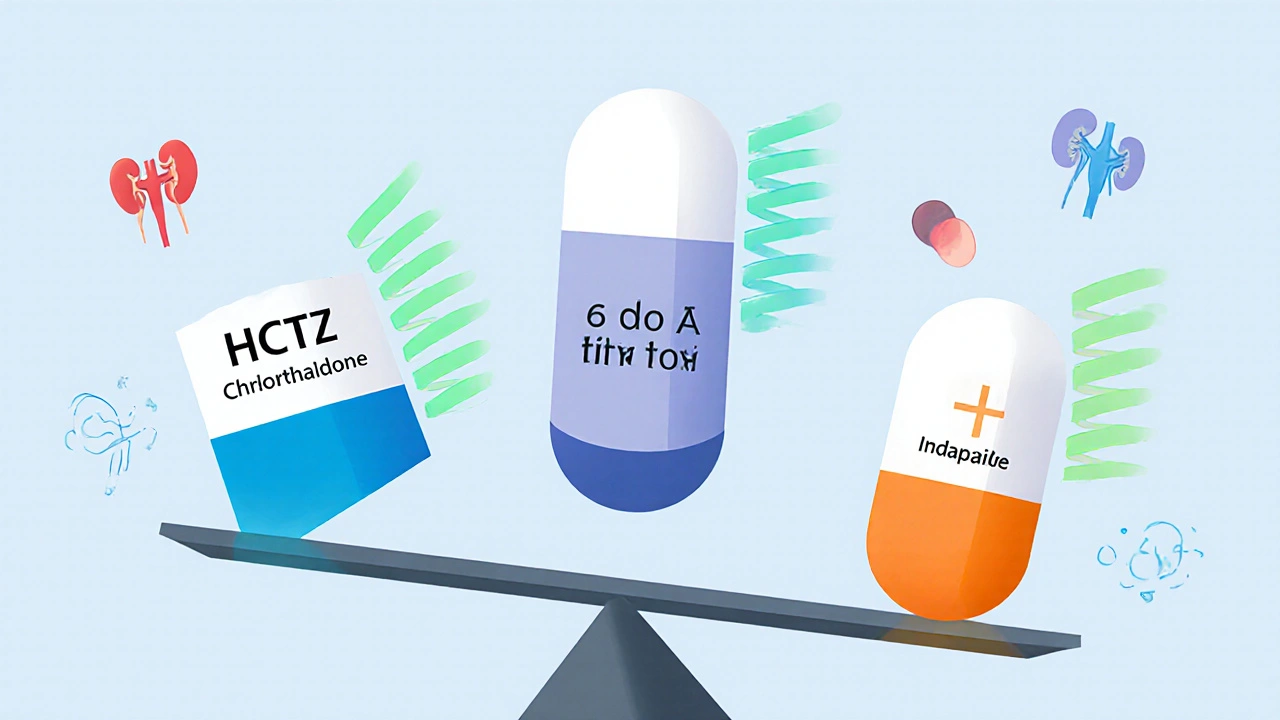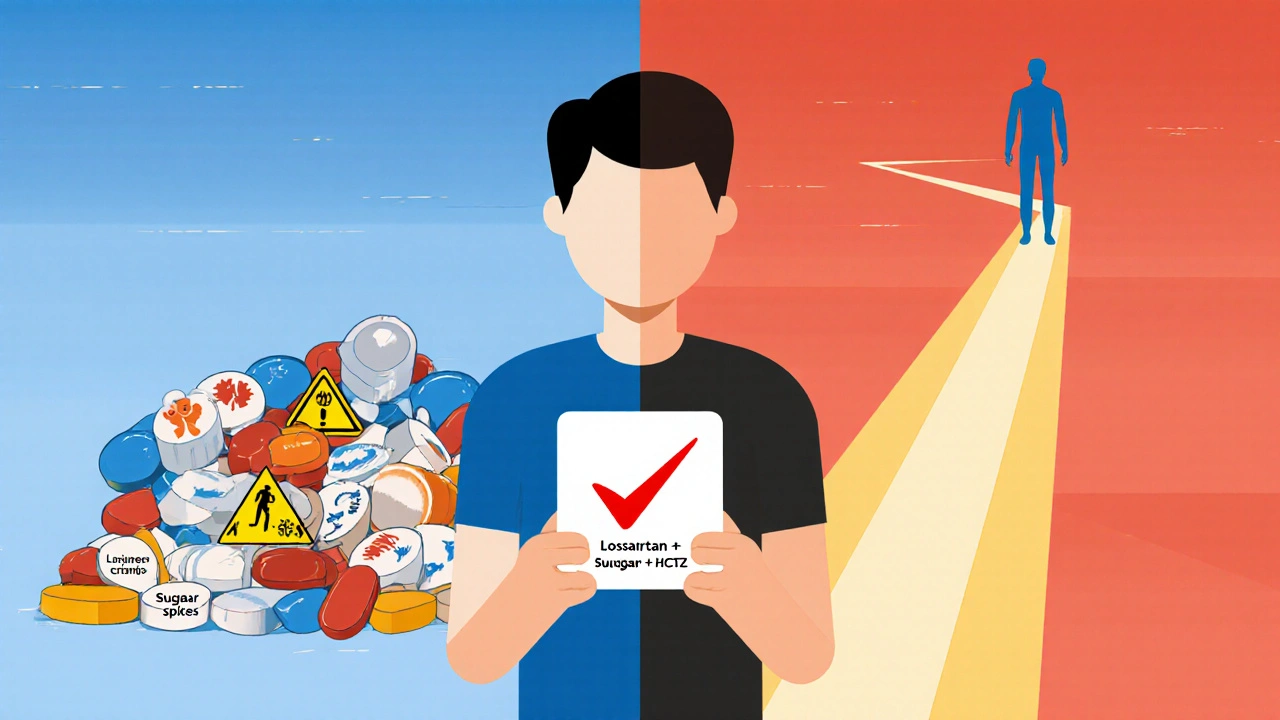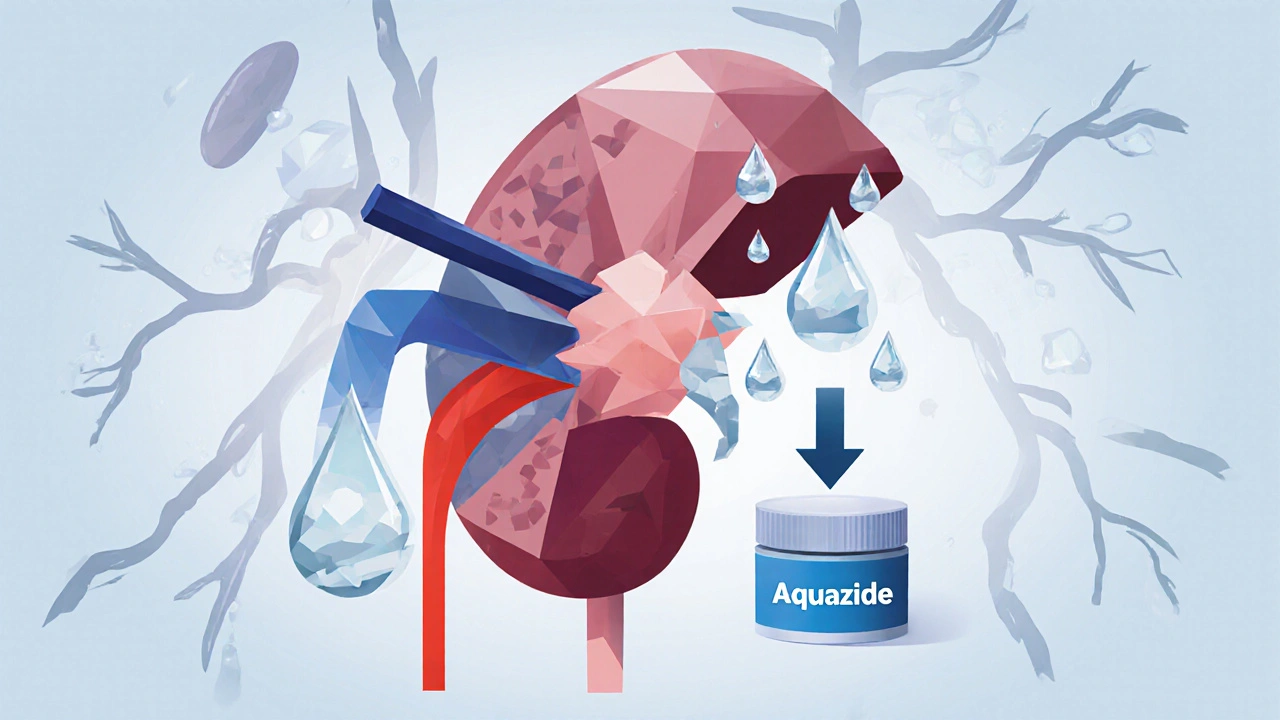Diuretic Alternative Calculator
Which Alternative Is Right for You?
Answer these questions to get personalized recommendations based on the latest clinical evidence.
High blood pressure and fluid retention don’t care how you feel about taking pills every day. If you’re on Aquazide - the brand name for hydrochlorothiazide - you’re probably tired of side effects, or maybe your doctor said it’s not working well enough anymore. You’re not alone. Thousands of people switch from hydrochlorothiazide every year, not because it doesn’t work, but because something else works better for them.
What Aquazide (Hydrochlorothiazide) Actually Does
Aquazide is a thiazide diuretic. That means it tells your kidneys to flush out extra salt and water. Less fluid in your blood vessels = lower blood pressure. It’s been around since the 1950s, and it’s still one of the most prescribed pills for hypertension in Australia, the US, and Europe.
But here’s the thing: Aquazide doesn’t just lower blood pressure. It also helps with swelling from heart failure, kidney problems, or liver disease. A typical dose is 12.5 to 25 mg once a day. It starts working in about 2 hours, peaks around 4 hours, and lasts 6 to 12 hours. Simple. But not always simple to tolerate.
Why People Look for Alternatives
People stop Aquazide for a few clear reasons:
- Frequent urination - especially at night
- Dizziness or low blood pressure when standing up
- Low potassium levels (hypokalemia), which can cause muscle cramps or irregular heartbeat
- High blood sugar - it can make prediabetes worse
- It just doesn’t bring blood pressure down enough on its own
A 2023 study in the Australian Journal of General Practice found that nearly 30% of patients on hydrochlorothiazide needed a second medication within 12 months. Others switched outright because of side effects. If you’re dealing with any of these, it’s worth looking at alternatives.
Chlorthalidone: The Stronger Cousin
Chlorthalidone is often called the "stronger" version of hydrochlorothiazide. It’s not brand-new - it’s been used since the 1950s too - but it’s been getting more attention lately.
Here’s how it stacks up:
- Dose: 12.5 to 25 mg daily - same as Aquazide
- Duration: Lasts 24 to 72 hours - so once-daily dosing is more reliable
- Effect on BP: Lowers systolic pressure about 10% more than HCTZ in head-to-head trials
- Side effects: Similar, but slightly higher risk of low potassium
The ALLHAT trial (a massive 10,000-patient study from the early 2000s) showed chlorthalidone reduced heart attacks and strokes better than hydrochlorothiazide over 5 years. That’s why the American Heart Association now lists it as a preferred first-line option.
But here’s the catch: chlorthalidone isn’t sold as a brand name in Australia. You’ll get it as a generic, and some pharmacies don’t stock it as often. Your doctor needs to specifically prescribe it.
Indapamide: The Middle Ground
Indapamide is a diuretic with a twist - it’s not just a water pill. It also relaxes blood vessels. That makes it a dual-action drug.
Compared to Aquazide:
- Dose: 1.25 to 2.5 mg daily - much lower than HCTZ
- Duration: 24 hours - steady effect all day
- Effect on BP: Similar to chlorthalidone, better than HCTZ in some studies
- Side effects: Less potassium loss than HCTZ, less impact on blood sugar
It’s approved in Australia for hypertension and is often used in combination pills. If you’re worried about your potassium levels or you have early signs of insulin resistance, indapamide might be a smoother fit. It’s sold under brand names like Lozol or Natrilix here.

Amiloride and Spironolactone: Potassium-Sparing Options
If low potassium is your main issue with Aquazide, you might want to skip replacing it - and just add a potassium-sparing diuretic.
Amiloride and spironolactone don’t flush out potassium. In fact, they help keep it in.
Amiloride is often paired with HCTZ in one pill (like Moduretic). It’s mild on its own, so it’s usually not used alone for high blood pressure. But if you’re on Aquazide and your potassium keeps dropping, adding amiloride is a quick fix.
Spironolactone is stronger. It’s also used for heart failure and fluid buildup in the abdomen. It can lower blood pressure by 10-15 mmHg. But it comes with trade-offs: men might get breast tenderness or reduced libido. Women might notice irregular periods. It’s not a first choice for everyone, but for some, it’s a game-changer.
ACE Inhibitors and ARBs: Not Diuretics, But Often Better
Here’s where things get interesting. Many doctors now start with an ACE inhibitor (like lisinopril) or ARB (like losartan) instead of a diuretic.
Why? Because they protect the kidneys, reduce protein in urine, and lower heart attack risk - all without messing with potassium or blood sugar like thiazides can.
For people with diabetes, chronic kidney disease, or heart failure, these are often preferred over hydrochlorothiazide. A 2024 meta-analysis showed ARBs reduced kidney damage by 20% more than HCTZ in patients with type 2 diabetes.
Side effects? A dry cough with ACE inhibitors (common). Dizziness (less than with diuretics). But no electrolyte crashes. If you’ve got kidney issues or metabolic concerns, this might be a smarter long-term move.
Combination Pills: The Smart Upgrade
Most people with high blood pressure need more than one pill. That’s why combination pills are so popular.
Instead of taking Aquazide alone, you might switch to:
- Hyzaar: Losartan + HCTZ
- Accuretic: Quinapril + HCTZ
- Atacand HCT: Candesartan + HCTZ
- Inspra: Eplerenone + HCTZ (for resistant hypertension)
These let you keep the diuretic effect while adding a blood vessel relaxer. Often, you get better control with lower doses - which means fewer side effects.
Some of these are available as generics now in Australia, making them affordable. Ask your pharmacist if your current prescription can be swapped for a combo pill.

What About Natural Alternatives?
You’ll see ads for "natural diuretics" - dandelion root, hibiscus tea, parsley, celery seed. They sound safe. But here’s the reality:
- None have been proven to lower blood pressure as reliably as prescription drugs
- Doses vary wildly between products
- They can interact with your other meds - especially if you’re on blood thinners or lithium
- They don’t help if your BP is dangerously high
Herbs aren’t magic. If your systolic pressure is above 160, you need proven medication. Natural options might help as a small bonus - like drinking hibiscus tea - but never as a replacement.
How to Decide What’s Right for You
There’s no single "best" alternative. The right one depends on your health profile:
- If you have low potassium → Try indapamide or add amiloride
- If your BP isn’t low enough → Switch to chlorthalidone or try a combo pill
- If you have diabetes or kidney disease → ACE inhibitor or ARB first
- If you’re male and worried about side effects → Avoid spironolactone unless absolutely needed
- If you’re over 65 → Chlorthalidone or indapamide often work better than HCTZ
Don’t switch on your own. Talk to your doctor. Get a blood test to check your potassium, sodium, and kidney function. Bring a list of your symptoms - not just "I feel tired." Say exactly when you feel dizzy, how often you wake up to pee, or if you’ve noticed swelling in your ankles.
What to Expect When Switching
Switching meds isn’t instant. It takes 2 to 4 weeks for your body to adjust. Your blood pressure might dip too low at first - especially if you’re on multiple drugs. That’s why doctors start low and go slow.
Keep a log for two weeks: write down your BP readings (if you check at home), how many times you use the bathroom, any dizziness, cramps, or fatigue. Bring it to your next appointment. That data is worth more than any guess.
Some people feel better within days. Others take weeks. If you feel worse after switching, don’t panic - but don’t ignore it either. Call your doctor.
Bottom Line: Aquazide Isn’t the Only Option
Aquazide helped millions. But it’s not perfect. If you’re struggling with side effects or it’s not controlling your blood pressure, you’re not failing - you just need a different tool.
Chlorthalidone, indapamide, ARBs, and combo pills are all proven, safer, and sometimes more effective. Your body isn’t broken. Your medication might just need an upgrade.
Talk to your doctor. Ask about alternatives. Bring your blood test results. And don’t let fear of change keep you stuck with something that doesn’t fit anymore.
Is Aquazide the same as hydrochlorothiazide?
Yes. Aquazide is a brand name for hydrochlorothiazide, which is the generic drug. They work the same way. The only difference is the price - generics cost a lot less. If your doctor prescribes Aquazide, ask if you can switch to hydrochlorothiazide. You’ll save money with no loss in effectiveness.
Can I stop Aquazide if I feel fine?
No. High blood pressure often has no symptoms. Feeling fine doesn’t mean your blood pressure is under control. Stopping Aquazide suddenly can cause your pressure to spike, increasing your risk of stroke or heart attack. Always talk to your doctor before stopping or changing your dose.
Which alternative has the fewest side effects?
Indapamide tends to have fewer side effects than hydrochlorothiazide - especially when it comes to potassium loss and blood sugar spikes. For people with diabetes or metabolic issues, ARBs like losartan are often better tolerated. But everyone reacts differently. What’s mild for one person might be annoying for another. Your doctor can help match the drug to your body.
Are combination pills better than taking two separate pills?
Yes, for most people. Combination pills reduce the number of tablets you take daily, which improves adherence. Studies show people are more likely to stick with their treatment when they take one pill instead of two. They also often use lower doses of each drug, which can reduce side effects. Many Australian pharmacies now stock generic combinations at low cost.
How long does it take to see results after switching?
You might notice changes in urination or energy levels within a few days. But it takes 2 to 4 weeks for your blood pressure to fully stabilize on a new medication. Don’t judge effectiveness too early. Keep tracking your readings and symptoms. Your doctor will usually schedule a follow-up in 3 to 4 weeks to check your progress.
Can I use natural diuretics like dandelion tea instead of Aquazide?
No. Natural diuretics aren’t strong or consistent enough to control high blood pressure. They can also interfere with your other medications - especially if you’re on lithium, digoxin, or blood thinners. Dandelion tea might help with mild bloating, but it won’t protect your heart or kidneys like prescription drugs do. Don’t risk your health with unproven alternatives.
If you’ve been on Aquazide for a while and it’s not working as well as it used to, you’re not alone. Many people find better control - and fewer side effects - with other options. The key is to talk to your doctor, get the right tests, and be open to change. Your blood pressure doesn’t have to be a daily battle.


Sage Druce
I switched from Aquazide to indapamide last year and my potassium levels stabilized overnight. No more cramps at 3am. My doctor was skeptical but the numbers spoke for themselves. I feel like a human again